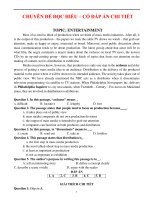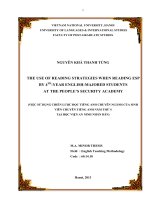Đọc hiểu tiếng anh (có đáp án)
Bạn đang xem bản rút gọn của tài liệu. Xem và tải ngay bản đầy đủ của tài liệu tại đây (35.37 KB, 4 trang )
You can usually tell when your friends are happy or angry by the looks on their faces or by their
actions. This is useful because reading their emotional expressions help you to know how to respond to
them. Emotions have evolved to help us respond to important situations and to convey our intentions to
others. But does raising the eyebrows and rounding the mouth say the same thing in Minneapolis as it
does in Madagascar? Much research on emotional expression has centered on such questions
According to Paul Ekman, the leading researcher in this area, people speak and understand
substantially the same “facial language”. Studies by Ekman’s group have demonstrated that humans
share a set of universal emotional expression that testify to the common biological heritage of the
human species. Smiles, for example, signal happiness and frowns indicate sadness on the faces of people
in such far- flung places as Argentina, Japan, Spain, Hungary, Poland, Sumatra, the United States,
Vietnam, the jungles of New Guinea, and the Eskimo villages north of the Artic Circle. Ekman and his
colleagues claim that people everywhere can recognize at least seven basic emotions: sadness, fear,
anger, disgust, contempt, happiness, and surprise. There are, however huge differences across cultures
in both the context and intensity of displays- the so called display rules. In many Asian cultures, for
example, children are taught to control emotional responses- especially negative ones- while many
American children are encouraged to express their fellings more openly. Regardless of culture, however,
emotions usually show themselves, to some degree, in people’s behavior. From their first days of life,
babies produce facial expressions that communicate their feelings.
The ability to read facial expressions develops early, too. Very young children pay close attention
to facial expressions, and by age five they nearly equal adults in their skill at reading emotions on
people’s faces. This evidence all points to a biological underpinning for our abilities to express and
interpret a basic set of human emotions. Moreover, as Charles Darwin pointed out over a century ago,
some emotional expressions seem to appear across species boudaries. Cross- cultural psychologists tell
us that certain emotional responses carry different meaning in different cultures. For example, what
emotion do you suppose might be conveyed by sticking out your tongue? For Americans, this might
indicate disgust, while in China it can signify surprise. Likewise, a grin on an American face may indicate
joy, while on a Japanese face it may just as easily mean embarrassment. Clearly, culture influences
emotional expression.
1. According to the passage, we respond to others by__________
A. observing their looks
B. watching their actions
C. looking at their face
D. observing their emotional expressions
2. Many studies on emotional expressions try to answer the question whether_______
A. raising the eyebrows has similar meaning to rounding the mouth
B. rounding the mouth has similar meaning in Minneapolis and Madagascar
C. Eyebrow raising means the same in Minneapolis and Madagascar
D. Different cultures have similar emotional expressions
3. The word “evolved” in line 3 of the first paragraph is closet in meaning to________
A. developed
B. reduced
C. simplified
4. Paul Ekman is mentioned in the passage as an example of ________
A. investigators on universal emotional expressions
B. researchers who can speak and understand many languages
C. researchers on universal language
D. lacked many main ingredients
5. Smiles and frowns______
A. are not popular everywhere
B. are universal expressions across cultures
C. have different meanings in different cultures
D. do not convey the same emotions in various cultures
6. The biggest difference lies in______
A. how emotional responses are controlled
B. how intensive emotionss are expressed
C. how long negative emotions are displayed
D. how often positive emotions are shown
7. Unlike American children, Asian children are encouraged to______
A. display their emotions openly
B. control their emotion
C. conceal their positive emotions
D. increased
D. change their behaviour
8. Young children_______
A. make amazing progress in controlling their emotions
B. take time to control their facial expressions
C. spend a long time learning to read others’ emotions
D. are sensitive towards others’ emotions
9. The phrase “this evidence” in line 3 of the third paragraph refers to______
A. a biological underpinning for humans to express emotions
B. the fact children can control their feelings
C. the fact that children are good at recognizing others’emotions
D. human facial expressions
10. The best title of the passage is________
A. Ways to control emotional expressions
B. A review of research on emotional expressions
C. Human habit of displaying emotions
D. Cultural universals in emotional expression
Vocabulary:
- respond (v) : đáp lại
- convey (v) : truyền đạt
- intention (n): ý định
- raise the eyebrows: nhướng mày
- round the mouth: mở tròn miệng
- facial language: ngôn ngữ cơ thể
- demonstrate (v): biểu lộ
- heritage (n): di sản
- testify (v): tỏ ra
- frown: cau mày
- indiacte (v): chỉ ra
- far- flung : trải rộng bao la
- fear (n): nỗi sợ
- disgust (n): sự phẫn nộ
- contempt (n): coi thường
- intensity (n): độ mạnh
- pay close attention: để ý kĩ
- underpinning (n): sự củng cố
- interpret (v): giải thích
- boundaries: điểm giới hạn
- Cross- cultural psychologists: tâm lý học đa văn hóa
- sticking out your tongue: lè lưỡi
- indicate: hướng đến
- likewise: tương tự như vậy
- grin: nụ cười toe toét
- embarrassment: sự lúng túng









